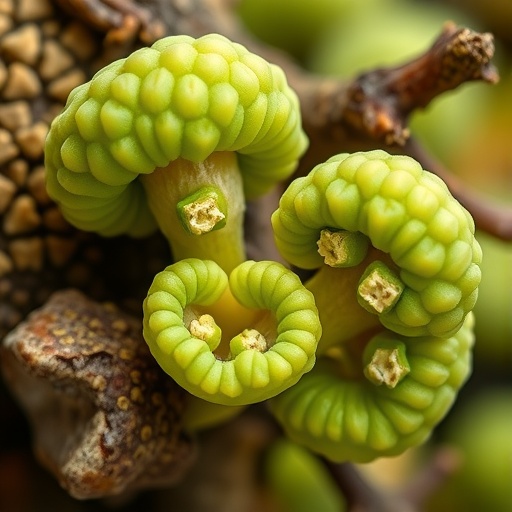In the quest for sustainable agricultural practices, researchers are continuously exploring innovative solutions to combat plant diseases and improve crop yield. A pivotal study led by Saberi-Riseh and Fathi introduces a groundbreaking approach to control pistachio gummosis, a devastating disease affecting pistachio trees, through the use of encapsulated Pseudomonas chlororaphis VUPF5. This research, published in International Microbiology, sheds light on both the biological mechanisms of this pathogen and the potential of biocontrol agents in disease management.
Pistachio gummosis is characterized by the exudation of gum from the trunk and branches, significantly impacting the health of pistachio trees. This disease not only causes physical damage but also invites secondary infections, leading to a sharp decline in yields. Traditionally, chemical treatments have been employed to manage such diseases; however, concerns surrounding environmental toxicity and resistance have driven the search for more sustainable alternatives.
The innovative use of Pseudomonas chlororaphis VUPF5 illustrates the shift towards biocontrol methods. This bacterium is known for its antagonistic properties against various plant pathogens. The encapsulation technique utilized in this study enhances the stability and delivery of the biocontrol agent, allowing it to thrive in the microenvironment of the plants. By effectively localizing the bacteria at the site of infection, researchers aim to maximize its protective effects on pistachio trees.
Encapsulation not only provides a protective barrier for the bacteria but also ensures a controlled release of the biocontrol agents, enhancing their efficacy. This novel delivery system represents a significant advancement in how biocontrol agents can be applied in agricultural settings. By leveraging the natural defenses provided by Pseudomonas chlororaphis VUPF5, farmers can potentially reduce reliance on synthetic pesticides, leading to a healthier ecosystem.
The findings of the study highlight not only the efficacy of the encapsulated bacteria but also its potential impact on improving the overall health of the pistachio trees. Enhanced plant vitality can result in an increase in yield and fruit quality, likely benefiting farmers economically. With pistachio production being a significant component of the agricultural economy, such advancements could have far-reaching implications for the industry.
Moreover, the adoption of biocontrol measures like this could pave the way for broader acceptance of biologically-based pest management strategies among growers. By demonstrating the effectiveness of natural solutions, researchers hope to encourage a paradigm shift in pest control methods. This is critical, especially in regions where environmentally friendly practices are increasingly prioritized.
The use of biocontrol agents aligns with global trends towards sustainable agriculture, where the focus is not only on productivity but also on preserving the environment and protecting biodiversity. The integration of microbial solutions into pest management practices is a testament to the growing field of agriculture that values both productivity and ecological health.
In this study, extensive laboratory and field tests were conducted to assess the effectiveness of the encapsulated Pseudomonas chlororaphis VUPF5 in real-world conditions. Results indicated a significant reduction in the severity of pistachio gummosis in treated trees compared to untreated controls. Such robust findings offer hope to farmers struggling with this persistent disease.
The research does not merely end with the demonstration of efficacy; it opens the door for further studies to explore the molecular mechanisms underlying the interactions between the biocontrol agent and the plant host. Understanding these mechanisms could lead to the development of enhanced strains of Pseudomonas chlororaphis or other beneficial microbes, optimizing their roles in plant health and disease resistance.
The study emphasizes the importance of interdisciplinary collaboration in agricultural research. By combining microbiology, plant pathology, and agricultural innovation, researchers are better equipped to tackle the challenges posed by plant diseases. This collaborative approach accelerates the development of effective and practical solutions that address both current and future agricultural dilemmas.
Additionally, educational outreach to farmers about the benefits and usage of biocontrol agents is crucial for the widespread acceptance and implementation of such practices. Workshops and seminars that provide hands-on demonstrations and scientific explanations will be essential in fostering an informed farming community.
As agricultural practices evolve, so too must the strategies employed to manage them. Researchers like Saberi-Riseh and Fathi are at the forefront of this evolution, providing vital insights into the future of pest control. Their work not only contributes to the scientific community but also serves as an inspirational model for incorporating biological strategies into everyday farming practices.
In summary, the innovation presented through encapsulated Pseudomonas chlororaphis VUPF5 represents a significant milestone in the quest for sustainable agricultural solutions. As more farmers adopt biocontrol methods, there arises a fantastic potential for enhancing crop health while ensuring the protection of our environment.
The implications of this research are profound, not only for the pistachio industry but also for global agriculture at large. The study serves as a reminder of the untapped potential of nature to collaborate with human ingenuity, promising a greener future for farming around the world.
With the publication of this significant research, it is clear that the path to sustainable agriculture is being paved by such pioneering work. As we delve deeper into the complexities of plant health and disease management, the role of biocontrol agents, particularly encapsulated microbial solutions, will likely become increasingly prominent.
By embracing these innovative practices, the agricultural community can move closer to achieving a balance between productivity and environmental stewardship, paving the way for a more sustainable future.
Subject of Research: Biocontrol of pistachio gummosis using encapsulated Pseudomonas chlororaphis VUPF5.
Article Title: Biocontrol of pistachio gummosis using encapsulated Pseudomonas chlororaphis VUPF5.
Article References:
Saberi-Riseh, R., Fathi, F. Biocontrol of pistachio gummosis using encapsulated Pseudomonas chlororaphis VUPF5.
Int Microbiol (2025). https://doi.org/10.1007/s10123-025-00723-x
Image Credits: AI Generated
DOI: https://doi.org/10.1007/s10123-025-00723-x
Keywords: Biocontrol, Pseudomonas chlororaphis, pistachio gummosis, sustainable agriculture, encapsulation, plant diseases.
Tags: antagonistic properties of Pseudomonasbiocontrol agents for plant diseasesbiological mechanisms of plant pathogensencapsulated Pseudomonas chlororaphisencapsulation techniques in agricultureenvironmental toxicity in agricultureimpact of pistachio diseases on yieldimproving crop health with bacteriainnovative disease management solutionspistachio gummosis controlsecondary infections in plantssustainable agricultural practices





